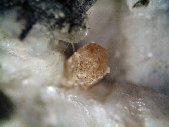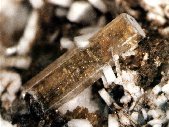Thumbnails

Burbankite crystal
© Doug Merson

Burbankite crystal
© Doug Merson

Burbankite crystals
© Reproduced courtesy of Canadian
Museum of Nature
Ottawa, Canada

Burbankite crystal – 7mm
© Gilles Haineault
(Na,Ca)(Sr,Ba,Ce)(CO
Mont Saint-Hilaire was the fourth reported locality for burbankite. It occurs as a rare accessory mineral in some environments. Many of the older specimens designated as burbankite are actually remondite-(Ce).
PHYSICAL CHARACTERISTICS:
Color is usually pale to lemon-yellow, orange-yellow, beige, white
and colorless with some color zoning.
Luster is vitreous to dull, and silky to dull on fibrous habit.
Diaphaneity is transparent to translucent, with opaque zones.
Crystal System is hexagonal; mc
Crystal Habits include excellent sharp well-formed, hexagonal or
dihexagonal prisms with a pinacoid; prismatic crystals with etched
or fibrous terminations; as compact spherical aggregates and as
pure fibrous masses.
Cleavage {100} is distinct to imperfect.
Fracture is uneven.
Hardness is 4.
Specific Gravity is approximately 3.5 g/cm
Streak is white.
Associated Minerals include aegirine, albite, analcime, anatase,
andradite, astrophyllite, barite, barylite, biotite, calcite, catapleiite,
donnayite, ewaldite, gonnardite, hilairite, ilmenite, molybdenite,
natrolite, paranatrolite, pyrite, pyrophanite, rutile, sphalerite and zircon.
Distinguishing Features: Crystal habit and color.
Origin: Named in 1955 for Wilbur Sweet Burbank (1898-1975),
geologist, U.S. Geological Survey.
CLASSIFICATION:
Dana System
# 14.4.4.1
Strunz Classification
# V/B.5-100
REFERENCES:
MinRec 21:300-301 (1990), Dana 8:459 (1997)
DISTRIBUTION AND RARITY AT MONT SAINT-HILAIRE:
MSH
¤¤¤

Burbankite crystals
© Modris Baum

Burbankite crystal
© Stephan Wolfsried
